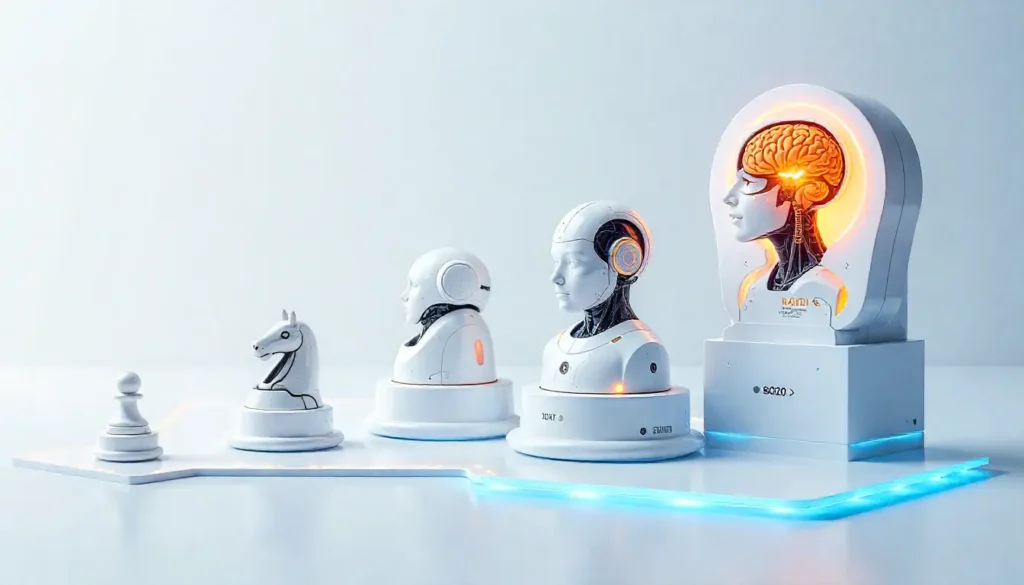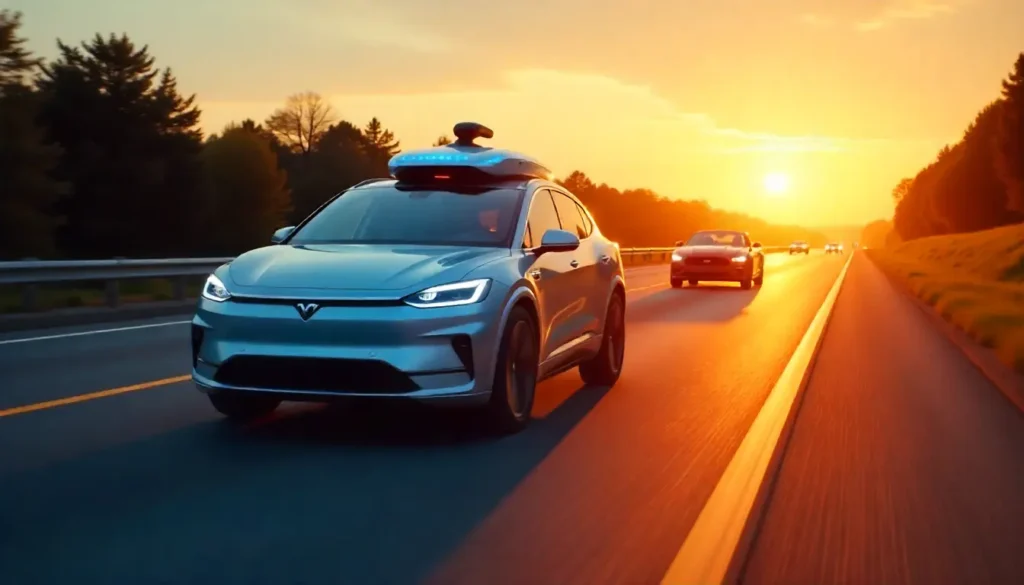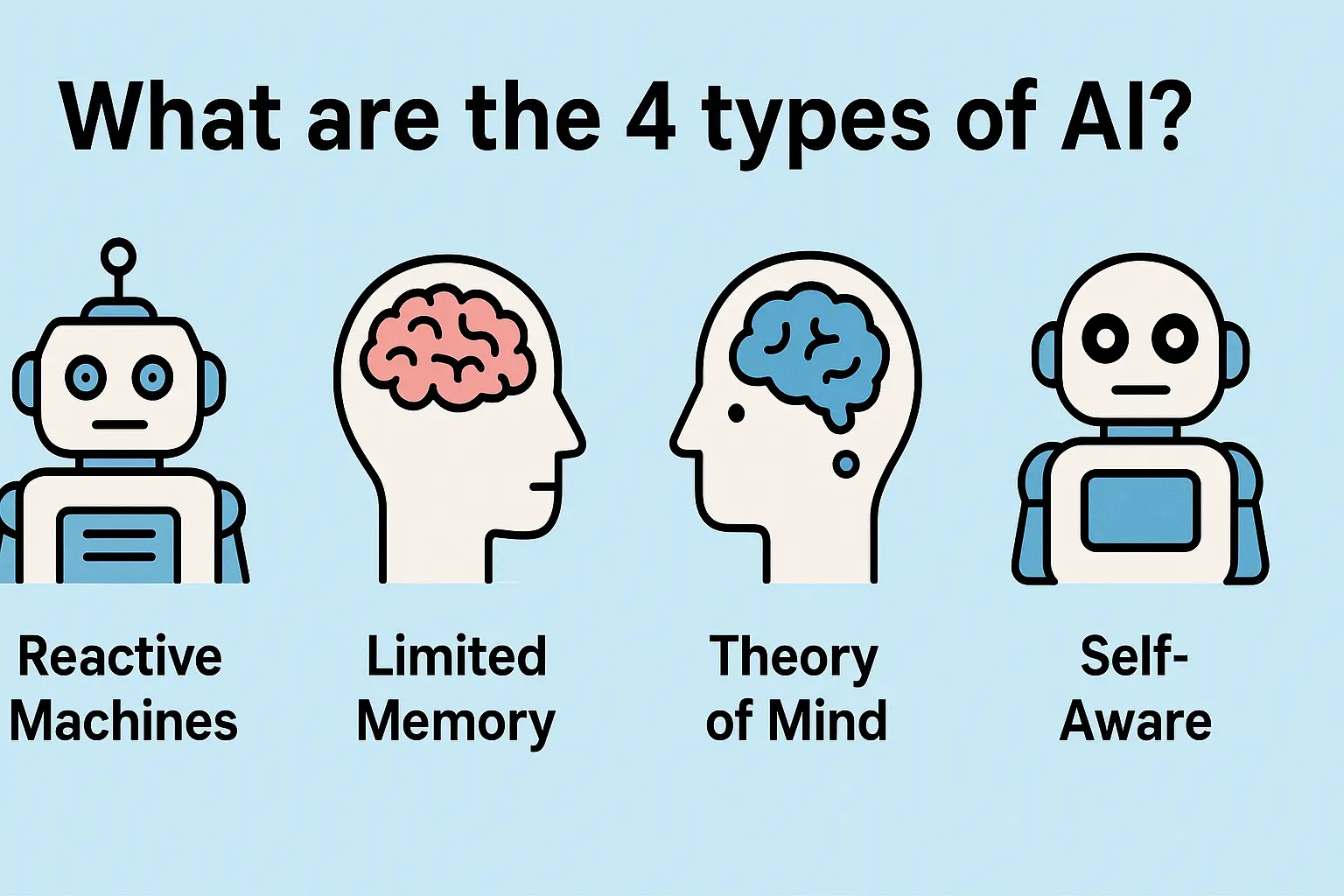Artificial intelligence is everywhere. It powers many tools we use. But not all AI is the same. AI has four major kinds. These kinds demonstrate the level of intelligence of a system. They are as simple as task machines and as advanced as the future. Knowing them will make us understand the direction that AI is taking.
These are the four, namely reactive, limited memory, theory of mind, and self aware. We will explore each one. We are going to observe their functionality and their applications in practice.

Table of Contents
Type 1: Reactive Machines
The simplest form of AI is reactive machines. They cannot form memories. They are also unable to use the past experiences. These systems don’t think ahead; they only respond to the circumstances they’re currently faced with. Every input is treated as an event. These systems are narrow-job oriented. At that one job they are very good.
One such well-known one is the Deep Blue of IBM. This computer defeated a champion of chess. It was not aware that it had played before. It merely examined the present board. It estimated the optimal follow-up. That is all it could do.
A spam filter is another typical example. It looks at an email. It verifies some words or patterns. Then it decides if it is spam. It does not study your previous mails. It just follows its rules.
Reactive machines are dependable. They are predictable. But they are very limited. They are not able to relate to the world dynamically. They are the foundation of AI.
Type 2: Limited Memory AI
A small step forward is limited memory AI. This form can peep into the past. It takes advantage of the latest information to make superior decisions. This group comprises most of the modern AI systems. They get informed by the past.
This education occurs via training. The AI is fed with large amounts of data by engineers. The AI discovers trends in this data. It employs these trends in making decisions in the future. The “memory” is not like ours. It is temporary and task oriented.
An ideal example is self driving cars.Such systems watch the speed and direction of nearby cars to make better driving decisions.They observe the location of lane lines. Driving decisions are made using this data. The car does not recollect your yesterday trip. It just takes the final few minutes of information.
Just like other AI systems, chatbots and virtual assistants come with limited memory and can only recall information for a short period. They check on your recent messages. This assists them to provide a pertinent response. They are trained on huge text data to sound more human.
This is the most widely used AI at the present. It is strong yet with definite boundaries.
Type 3: Theory of Mind AI
Theory of mind is the second level. This type does not exist yet. It is an objective in future research. This AI would realize that individuals think. It would be aware of feelings and ideologies. It could interact socially.
Human intentions would be obtained by a theory of mind AI. It would understand that a person may have another aim. This is essential towards genuine two way communication. It would enable AI to be a real partner.
Imagine a useful home robot. It would not simply obey instructions. It would know that you are frustrated and alter its course. It would know that sadness is frowning.
This implies a huge technological jump. We are not there yet. Researchers are toiling on fundamentals. Such AI would require profound social smarts.
Type 4: Self-Aware AI
The last type is self aware AI. It is science fiction. It is a conscious machine. It would know it exists. It would possess its needs and wants.
This artificial intelligence would be aware of its internal state. It could feel emotions. It would be intelligent and conscious as a human being. The concept is commonly referred to as Artificial General Intelligence, often shortened to AGI.
No such system exists today. It may be far in the future. Its development provokes serious ethical issues. What would a self conscious machine have in the way of rights? How would we control it? This has become a big subject to philosophers and scientists.
This is the final aim of certain researchers. Another popular fear of AI stories is also common.As of now, this still exists only as a hypothetical concept rather than a real-world application.
The way these kinds of AI collaborate with each other.
These four types show a path. They demonstrate the increasing intelligence of AI. Each type builds on the last. The foundation is reactive machines. Learning is added to limited memory.
The types of the future will bring more insight. Limited memory AI is what we are learning to master now. In recent years, there has been a steady shift in research, with more attention being directed toward theory of mind AI. Self awareness is a far off dream.
A large number of systems now integrate reactive and limited memory components. A robot vacuum is largely reactive. But it can get to know the layout of your home as time progresses. That is some kind of short term memory. The majority of effective AI applications are built on analyzing and learning from past data.

Real-World Uses of Each Type
Reactive Machines:
- Deep Blue chess playing computers.
- Basic spam filters for email.
- Factory robots that perform a single task over and over.
- The recommendation engine of Netflix (primarily reactive).
Limited Memory AI:
- Autopilot vehicles of such a company as Tesla.
- Siri and Alexa voice assistants.
- Face recognition in your phone.
- Chatbots on customer services online.

Theory of Mind AI:
- This type has no real uses yet.
- Studies are going on in laboratories.
- It can initially be introduced in advanced therapy bots.
Self-Aware AI:
- No practical uses exist.
- It exists in films and fiction only.
The Future of AI Types
The future of AI is exciting. Greater limited memory systems will be seen. They will become more efficient learners with less data. The shift to theory of mind will be gradual. It needs a fresh approach to code.
We will perhaps never produce a really self conscious machine. But the trip there will invent fantastic instruments. Such tools will assist us in most aspects of our life. They will make automobiles safer and doctors more precise.
Knowledge of these four types makes us observe this advancement. It demonstrates us of the progress we have made. It also depicts the distance that we have not traveled. The machine which will know us is the next big breakthrough.
Frequently Asked Questions For 4 Types of AI
Q1.What is the most widespread form of AI?
The most usual is limited memory AI. It is applied to self-driving vehicles and voice assistants.
Q2.What is a reactive machine?
This is only a limited AI system, as it does not have the capability to learn or adapt on its own.It is just a reaction to existing information, as a chess computer.
Q3.Does self-aware AI exist?
No, there is no self-conscious AI. It is a post-research theoretical concept.
Q4.What is theory of mind AI?
It is an AI of the future that would comprehend human thoughts and feelings. It is not built yet.


1 thought on “What Are The 4 Types of AI?”